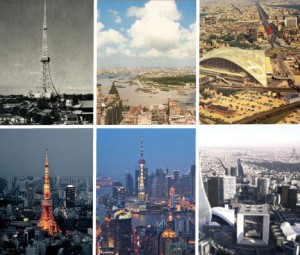http://weburbanist.com/2011/02/21/then-now-the-stunning-speed-of-urban-development/
The answer to our problems lies with buildings. Do you actually believe you can separate buildings out from the infrastructure of cities and mobility of transit and the expectations and incentives of people? I believe that we cannot separate buildings out from the infrastructure of cities and mobility of transit and expectations and incentives of people. They are directly proportional to each other. Each one cannot co-exist without the other.it is easy to construct a building without an infrastructure of a city but the building would not last for too long.it would be dead or lifeless whether people are living in it or not.it requires infrastructure to thrive and live. They make up the city and the urban fabric. Cities infrastructures are networks, functional networks that allow the connected buildings to make optimal use of their design. Architects therefore need to consider a lot of parameters before constructing a building, that’s why as a student we our taught to annalise the sight, surroundings and context. A site context is more important that the building itself. If a building does not respond to the site/context it is a failure of design on the architects part or job. With an intelligent infrastructure the architect can thus save cost,time and money/respect the economy and the expectations and incentives of people ,providing them with a perfect environment to live in. Why do people tend to believe that what is financially profitable (for developers) is not actually equivalent to economically feasible (positive impacts on social welfare)? How would you show that this does not necessarily have to be like this (but rather the opposite)? What is financially profitable for developer can also be equivalent to economic feasibility. They can go hand in hand if the architect and the developer work in collaboration and each one doesn’t think about their own profit instead creating a sustainable environment/architecture. A sustainable environment posits a desirable future state for human societies in which living conditions and resource-use meet human needs without undermining the sustainability of natural systems and the environment, so that future generations may also have their needs met. It ties together concern for the carrying capacity of natural systems with the social and economic challenges faced by humanity. It emphasizes that in sustainable development everyone is a user and provider of information. It stresses the need to change from old sector-centered ways of doing business to new approaches that involve cross-sectoral co-ordination and the integration of environmental and social concerns into all development processes. Sustainable architecture has been taken seriously since the past few years in India, in trying to build a green environment.an example of one such city in India is Auroville in Puducherry where architects from various parts of the world come and join together to build an eco-friendly architecture minimizing the effects of globalization. Auroville, a growing international township near Puducherry on the Coromandel Coast in India, is an inspiring model for sustainable practices and ecologically-responsible living. Founded in 1968, Auroville is based on the vision of The Mother from the Sri Aurobindo Ashram and is endorsed by UNESCO and Government of India as an ongoing experiment in human unity. Over the years, Auroville has won international acclaim for its efforts in social and environmental sustainability. Aurovilians have been constantly experimenting with new ideas and solutions in areas of forestation, organic farming, renewable energy, water management, waste treatment, building technologies and environmental awareness programmes among others. One of the unique aspects of research in Auroville is the fact that many ideas are put into practice. Not only Auroville, many such cities are taking up an initiative (architects along with developers as a part of a big organization) to build and economically sustainable environment/city.
